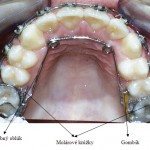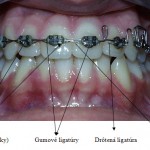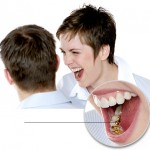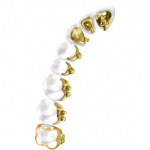
Appliance types
Dental anomaly treatment exists in various ways. These depend on the type of the anomaly, age of the patient, methods of the respective surgeon, demands of the patient on the result of the treatment, willingness of the patient to co-operate in the course of the treatment, as well as on the financial possibilities of the patient. All the above criteria influence the choice of the appliance.
Removable appliances
The patient inserts the removable appliance into his/her mouth for a certain part of the day and can also take it out by him-/herself any time. The time of the application of the appliance in the course of day and night depends on the type of the appliance, as well as on the degree of the anomaly. The appliance usually consists of an acrylic body and wire clasps and other parts. It can be used at any age, the most frequent use being , with younger children, in the period of mixed dentition, for the improvement of inter-jaw relations, e.g. in the case of large overjet or reverse bite. Removable appliances can have different shapes, some of them being pre-fabricated, but most frequently they are made by a dental technician according to the proposal of the orthodontist – individually for the respective patient. They often serve also for the modification of the structures around the jaws and teeth, muscles of the cheeks, lips, tongue, chewing muscles, and joints. In this way they, in a secondary effect, influence the shapes of the dental arches, and the interrelations of the jaws.
Advantages of removable appliances:
They don’t make teeth cleaning more difficult. If used at night they don’t cause an aesthetic handicap. They are cheaper than fixed appliances.
Disadvantages of removable appliances:
Their effect is limited and often slow. They don’t enable a perfect aesthetic and functional positioning of every tooth. Their effect depends on disciplined regular wearing. They are not suitable for some cases.
Fixed appliances
Fixed appliances consist of various parts (brackets and bands) fixed to teeth during the whole period of treatment, and of wires attached to these parts. The brackets can be fixed to the outer or to the inner surface of the teeth. When fixed to the inner side we call it lingual technique. Fixed appliances are usually made by the surgeon directly in the mouth of the patient. The patient is not able to take them out of his/her mouth. In our country fixed appliances are used mostly with permanent teeth, when the patient can master more demanding mouth hygiene. There is no upper age limit for this treatment.
Advantages of fixed appliances:
They work precisely and relatively fast. They enable effective treatment of most irregularities of the dentition. They work for 24 hours a day.
Disadvantages of fixed appliances:
They make teeth cleaning more difficult, but perfect cleaning is a precondition to successful treatment. The consistence of food must be accommodated to the appliance since biting of hard or crunchy meals can damage the appliance. The appliance fixed to the outer surface is visible on the teeth. If the parts are situated on the interior side of the teeth (in direction to the palate or tongue), they make an obstacle to speech and getting accustomed to the appliance takes a longer time, since the tongue is irritated by it.
Incognito Lingual Braces:
Invisible aligners
Transparent removable aligners (e.g. Invisalign etc.) are worn at all times except during meals. Several different aligners may be required over the course of treatment depending on the severity of the malocclusion. They are suitable for all ages, but are most widely used by adults to correct mild irregularities.
Advantages of invisible aligners:
They are removable and do not make teeth cleaning more difficult. They are more aesthetic then vestibular fixed appliances.
Disadvantages of invisible aligners:
Their effectiveness depends on disciplined regular wearing. They are not suitable in all cases.





